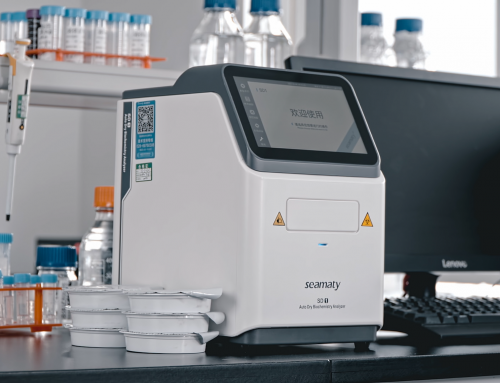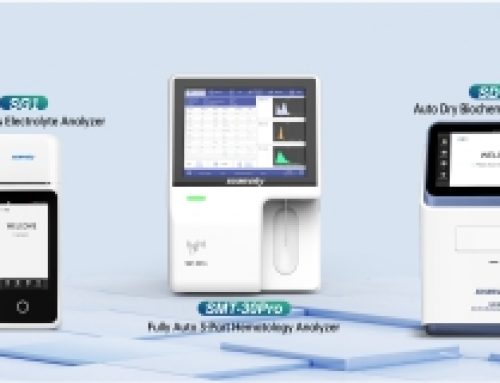Blood gas analyzers are critical tools in healthcare, providing real-time data on a patient’s respiratory function, acid-base balance, and electrolyte levels—information that guides treatment for conditions like respiratory failure, sepsis, and diabetic ketoacidosis. To deliver reliable results, these devices rely on specialized sensors, precise calibration, and efficient sample processing. Understanding the blood gas analyzer working principle is key to recognizing why not all devices perform equally—especially in on-site or emergency settings where speed and portability matter most.
The Seamaty SG1 Blood Gas & Electrolyte Analyzer reimagines the blood gas analyzer working principle for point-of-care (POC) use. By integrating advanced biosensor technology, automated calibration, and a streamlined workflow, the SG1 delivers lab-quality results in just 4 minutes—all in a handheld, battery-powered design. Below, we break down the core components of the blood gas analyzer working principle and explain how the Seamaty SG1 optimizes each step for on-site efficiency.
1. The Core of Blood Gas Analyzer Working Principle: Sensor Technology
At the heart of every blood gas analyzer is a set of specialized sensors that measure key parameters directly from whole blood. These sensors are engineered to detect specific molecules or ions, converting biological signals into quantifiable data. The Seamaty SG1 uses four primary sensor types, each tailored to a critical parameter group—ensuring accuracy and speed for POC testing.
1.1 pH Sensors: Measuring Acid-Base Balance
The pH of blood reflects its acid-base status, a key indicator of respiratory and metabolic health. The blood gas analyzer working principle for pH relies on a Sanz electrode (a type of glass electrode) that generates a voltage proportional to the concentration of hydrogen ions (H⁺) in the sample.
- How it works: The Sanz electrode contains a reference solution with a known pH (e.g., 7.38) and a thin glass membrane that is permeable to H⁺ ions. When blood comes into contact with the membrane, H⁺ ions diffuse across it, creating a voltage difference between the sample and the reference solution. The analyzer measures this voltage and converts it to a pH value (normal range: 7.35–7.45).
- SG1 Advantage: The SG1’s miniaturized Sanz electrode is integrated into a single-use test card, eliminating cross-contamination between samples. Its rapid response time (≤30 seconds) ensures pH results are available quickly—critical for managing acidosis or alkalosis in emergencies.
1.2 pCO₂ Sensors: Monitoring Carbon Dioxide Levels
Partial pressure of carbon dioxide (pCO₂) indicates how well the lungs are eliminating CO₂, a byproduct of metabolism. The blood gas analyzer working principle for pCO₂ uses a Severinghaus electrode, a modified pH electrode with a CO₂-permeable membrane.
- How it works: The Severinghaus electrode is filled with a bicarbonate buffer solution. When blood is introduced, CO₂ diffuses through the membrane and reacts with water in the buffer to form carbonic acid (H₂CO₃), which dissociates into H⁺ and HCO₃⁻ ions. This increases the H⁺ concentration, lowering the buffer’s pH. The electrode measures this pH change and calculates pCO₂ (normal range: 35–45 mmHg) using the Henderson-Hasselbalch equation.
- SG1 Advantage: The SG1’s Severinghaus electrode is calibrated in real time (via built-in QC) to account for temperature fluctuations (5–32°C operating range). This ensures accurate pCO₂ readings even in variable on-site environments, such as ambulances or rural clinics.
1.3 pO₂ Sensors: Assessing Oxygenation
Partial pressure of oxygen (pO₂) measures how much oxygen is dissolved in the blood, reflecting respiratory efficiency. The blood gas analyzer working principle for pO₂ uses a Clark electrode, an amperometric sensor that generates a current proportional to oxygen concentration.
- How it works: The Clark electrode consists of a platinum cathode and a silver-silver chloride anode, immersed in an electrolyte solution and covered by an oxygen-permeable membrane. When a voltage is applied to the cathode, oxygen diffusing through the membrane is reduced (O₂ + 2H₂O + 4e⁻ → 4OH⁻), generating a current. The analyzer measures this current and converts it to a pO₂ value (normal range: 80–100 mmHg for room air).
- SG1 Advantage: The SG1’s Clark electrode is optimized for low sample volumes (just 100μL of whole blood). Its high sensitivity allows it to detect even small changes in pO₂—essential for monitoring patients on mechanical ventilation or with respiratory distress.
1.4 Electrolyte Sensors: Measuring Ions Like K⁺, Na⁺, and Ca²⁺
Electrolytes (e.g., potassium, sodium, ionized calcium) regulate nerve function, muscle contraction, and fluid balance. The blood gas analyzer working principle for electrolytes uses ion-selective electrodes (ISEs), which respond selectively to specific ions.
- How it works: Each ISE has a membrane that binds to a target ion (e.g., K⁺) and excludes others. When the membrane comes into contact with blood, the target ion binds to it, creating a voltage difference between the sample and a reference electrode. The analyzer measures this voltage and calculates ion concentration (e.g., normal K⁺: 3.5–5.0 mmol/L).
- SG1 Advantage: The SG1 integrates ISEs for K⁺, Na⁺, Cl⁻, and Ca²⁺ into its test card, enabling simultaneous electrolyte testing. Its zero-cross-contamination design (individual channels for each ion) ensures results are not skewed by residual ions from previous samples—a common issue with reusable electrodes.
Even the most advanced sensors cannot deliver accurate results if the sample is mishandled. The blood gas analyzer working principle relies on proper sample collection, handling, and introduction to the sensors. The Seamaty SG1 streamlines this process for POC use, minimizing pre-analytical errors.
2.1 Sample Requirements: Whole Blood Compatibility
Most blood gas analyzers require arterial blood (the gold standard for pO₂ and pCO₂), but venous blood can be used for electrolyte or metabolic testing. The blood gas analyzer working principle depends on heparinized blood to prevent clotting, which would block sensors and invalidate results.
- SG1 Advantage: The SG1 accepts both arterial and venous whole blood, giving clinicians flexibility in sample collection. Its test card contains a pre-measured amount of heparin, eliminating the need for manual anticoagulant addition. This reduces user error and ensures consistent sample quality.
2.2 Sample Introduction: The 3-Step SG1 Workflow
Traditional blood gas analyzers require manual pipetting or sample loading, increasing the risk of air bubbles (which falsely elevate pO₂) or clotting. The Seamaty SG1 simplifies sample processing with a user-friendly, automated workflow:
- Add Sample: 100μL of whole blood is dropped onto the test card’s sample port. The card’s capillary action draws the blood into the sensor chamber, eliminating air bubbles.
- Insert Cartridge: The test card is inserted into the SG1. The analyzer automatically recognizes the card via QR code, initiating calibration and sensor activation.
- Read Result: The SG1 processes the sample for 50 seconds, then displays and prints results (via built-in thermal printer) in 4 minutes.
This workflow aligns with the blood gas analyzer working principle by ensuring samples are introduced to sensors quickly and consistently—critical for maintaining sample integrity (e.g., preventing CO₂ loss or oxygen gain).
2.3 Pre-Analytical Error Mitigation
Pre-analytical errors (e.g., delayed testing, air contamination) are the leading cause of inaccurate blood gas results. The blood gas analyzer working principle requires samples to be analyzed within 15 minutes of collection to avoid changes in pO₂, pCO₂, or pH.
- SG1 Advantage: The SG1’s 4-minute turnaround time ensures compliance with this requirement. Its test card’s airtight design prevents gas exchange between the sample and the environment, preserving pO₂ and pCO₂ levels during processing. Additionally, the SG1 alerts users to clotted samples (via real-time QC), preventing invalid results.
3. Calibration: Ensuring Accuracy in the Blood Gas Analyzer Working Principle
Calibration is the process of adjusting sensors to match known reference values, a cornerstone of the blood gas analyzer working principle. Without proper calibration, sensors drift over time, leading to inaccurate results. The Seamaty SG1 automates calibration to ensure reliability in POC settings.
3.1 Two-Point Calibration for Gas Sensors
Most blood gas analyzers use two-point calibration for pCO₂ and pO₂, using two reference gases with known concentrations (e.g., 5% CO₂/20% O₂ and 10% CO₂/0% O₂).
- How it works: The analyzer exposes the pCO₂ and pO₂ sensors to each reference gas, measuring the sensor’s response. It then creates a calibration curve, which it uses to convert sample sensor responses to accurate pCO₂ and pO₂ values.
- SG1 Advantage: The SG1’s test card contains pre-calibrated reference chambers, eliminating the need for external gas tanks. This makes calibration portable and easy—no specialized training required. The analyzer runs a two-point calibration automatically for each test card, ensuring results are accurate every time.
3.2 One-Point Calibration for Electrolytes and pH
Electrolytes and pH use one-point calibration, comparing sensor responses to a single reference standard (e.g., a known pH buffer or electrolyte solution).
- How it works: The analyzer measures the sensor’s response to the reference standard and adjusts it to match the known value. This corrects for minor sensor drift and ensures consistency.
- SG1 Advantage: The SG1’s test card includes a built-in reference pad for one-point calibration. This is integrated into the workflow, so users don’t need to perform manual calibration steps—saving time and reducing error.
3.3 Real-Time Quality Control (QC)
QC is an extension of calibration, verifying that sensors are performing within acceptable limits. The blood gas analyzer working principle requires QC to be run regularly (e.g., every 8 hours) to detect sensor malfunction.
- SG1 Advantage: The SG1 runs real-time QC for every test, using internal reference standards in the test card. If a sensor’s response is outside the acceptable range, the analyzer alerts the user and invalidates the result. This ensures only reliable data is used for patient care—critical in emergency settings where decisions are time-sensitive.
4. Co-Oximetry: Expanding the Blood Gas Analyzer Working Principle
Many modern blood gas analyzers include co-oximetry, a technology that measures hemoglobin (Hb) species (e.g., oxyhemoglobin, carboxyhemoglobin). This extends the blood gas analyzer working principle to assess oxygen-carrying capacity, not just dissolved oxygen.
4.1 How Co-Oximetry Works
Co-oximetry uses spectrophotometry, measuring how blood absorbs light at different wavelengths. Each Hb species (oxyhemoglobin, deoxyhemoglobin, carboxyhemoglobin, methemoglobin) absorbs light uniquely, allowing the analyzer to calculate their concentrations.
- Example: Oxyhemoglobin (O₂Hb) absorbs light at 660 nm, while deoxyhemoglobin (HHb) absorbs at 940 nm. The analyzer measures absorption at these wavelengths and uses a mathematical algorithm to determine the percentage of each Hb species (normal O₂Hb: ≥95%).
- SG1 Advantage: The SG1’s co-oximetry module is integrated into the test card, measuring total hemoglobin (cHgb) and oxyhemoglobin saturation (cSO₂) alongside pO₂. This provides a complete picture of oxygenation—critical for managing anemia, carbon monoxide poisoning, or methemoglobinemia.
5. Why Seamaty SG1 Excels at the Blood Gas Analyzer Working Principle
Traditional blood gas analyzers are large, complex, and limited to central labs—failing to meet the needs of on-site care. The Seamaty SG1 optimizes the blood gas analyzer working principle for POC use with:
- Handheld Portability: Weighing just 600g and powered by a 5000mAh battery, the SG1 can be used anywhere—patient bedsides, ambulances, or remote clinics.
- Single-Use Test Cards: Eliminate cross-contamination and simplify maintenance, aligning with the blood gas analyzer working principle’s need for sample integrity.
- Rapid Results: 4-minute turnaround time ensures timely treatment decisions, addressing the time-sensitive nature of blood gas testing.
- Real-Time QC & Calibration: Automates critical steps to ensure accuracy, even for untrained users.
To learn more about how the Seamaty SG1’s design aligns with the blood gas analyzer working principle—and how it can transform your on-site diagnostic workflow.
For inquiries about test card options (e.g., human vs. veterinary parameters), pricing, or regional support, contact Seamaty’s customer team today. With the SG1, you’re not just getting a blood gas analyzer—you’re getting a tool that brings lab-quality diagnostics to the point of care.






Leave A Comment